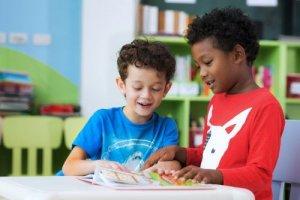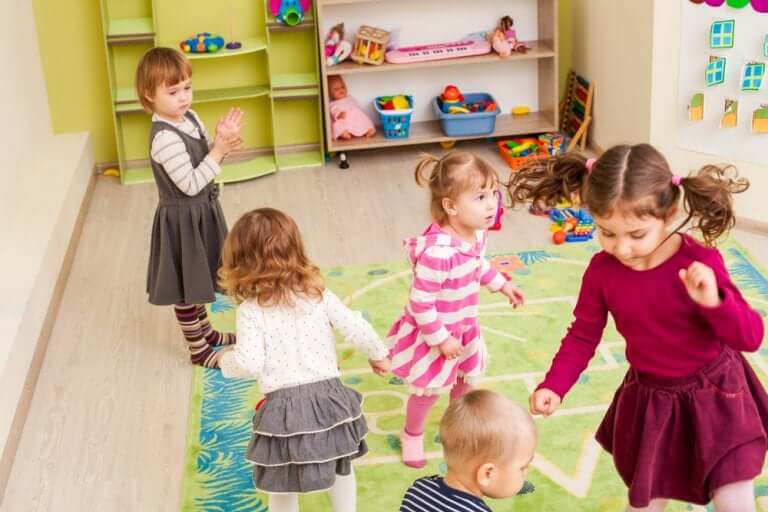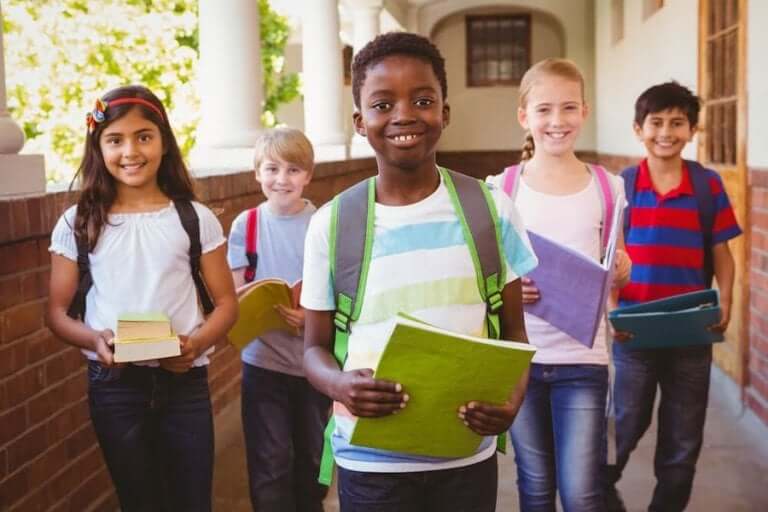How to Teach Social Skills in the Classroom

Social skills in the classroom come into play when children interact with everything around them, whether that be with their peers, objects at school, or with their teacher. These skills are different from those used at home. So, how do you work on them in the classroom?
In the classroom, early learning goes beyond drawing shapes or writing names. At school, children acquire the tools they need to socialize. This interaction with others ranges from greeting them at the beginning of the day to sharing materials and toys. It also involves discovering their friends’ emotions, and how to deal with moments of anger or frustration.
The role that the institution plays in this respect is to stimulate the harmonious development of social skills in the classroom. Although the repertoire of behavior types and attitudes isn’t the same at home as at school, it’s true that the latter helps to enrich social expression among their peers.
Children can learn social skills in the classroom
- From the experience itself. This is when, after a positive or negative experience, the child reaches a conclusion and is able to continue experimenting in the subsequent interactions they have.
- By advice or rule. Basically, this is when an institution defines the rules of coexistence. This also applies to all the observations that build each individual child’s ethical principles.
In the classroom, children observe, listen, reflect, exchange ideas, decide for themselves and identify what other children are feeling. The institution then tries to strengthen certain skills to enable the coexistence in the group to be as empathetic and harmonious as possible.
Social skills in the classroom can be learned on a day-to-day basis. Below are some guidelines for carrying this out.
Talking about emotions
When children are upset, not only must you listen and attend to them, allowing them to express themselves, but you must also teach them to identify what they’re feeling. One of the things that frustrates them the most is the difficulty of explaining to others what’s happening, and understanding it themselves.
When children are able to understand each other, then they generally calm down and learn to manage their frustrations. Talking, reading a story, drawing, and playing with things are some possible ways of doing this.

Setting clear rules
A child who knows what the rules are will more easily be able to adapt to that space. By feeling part of a whole group, they’ll start to feel a responsibility for the common good of the whole class.
In order to do this, a teacher will explain how to use and treat each area, toy, and piece of equipment. They’ll also explain how they need to behave with these items and areas.
Looking out for others
Teaching social skills in the classroom involves not only each child’s individual experience, but also the group as a whole. So, in order to develop these skills, it’s essential to promote empathy among peers. A teacher can achieve this in several different ways:
- Asking questions about other children’s emotions, so that everyone can consider how each one is feeling.
- Using conflicts as an opportunity to reflect on causes, feelings, and ways of resolving them.
- Helping to interpret non-verbal language, so that children can understand how other children are feeling just by observing them.
Talk about social skills in the classroom
Each day, a teacher will need to be attentive to the emotional needs of their class. By detecting common factors regarding the skills and abilities that need to be developed at school, they can talk directly about what each skill or ability means.
Some factors to create better socialization
In order for children to learn how to socialize in the classroom, these aspects are important:
- Expressing feelings and needs so that the other person can understand me
- Asking for help and not assuming that the other person will guess what I need
- Helping any person who needs it
- Complementing or encouraging a friend
- Learning to listen to stories or anything that a friend wants to tell me
- Learning to say “no” respectfully
- Resolving conflicts fairly
- Taking turns
- Sharing materials
- Respecting other children’s work without destroying or interrupting
- Respecting my friend’s body and space
- Learning how to invite friends to play

Finally, in order to teach social skills in the classroom, it’s a good idea to promote discussion in the group. To do this, teachers must give examples and allow children to question and analyze concepts. Even though they may be brief, group discussions are indispensable for applying what has been learned to a group setting.
Social skills in the classroom come into play when children interact with everything around them, whether that be with their peers, objects at school, or with their teacher. These skills are different from those used at home. So, how do you work on them in the classroom?
In the classroom, early learning goes beyond drawing shapes or writing names. At school, children acquire the tools they need to socialize. This interaction with others ranges from greeting them at the beginning of the day to sharing materials and toys. It also involves discovering their friends’ emotions, and how to deal with moments of anger or frustration.
The role that the institution plays in this respect is to stimulate the harmonious development of social skills in the classroom. Although the repertoire of behavior types and attitudes isn’t the same at home as at school, it’s true that the latter helps to enrich social expression among their peers.
Children can learn social skills in the classroom
- From the experience itself. This is when, after a positive or negative experience, the child reaches a conclusion and is able to continue experimenting in the subsequent interactions they have.
- By advice or rule. Basically, this is when an institution defines the rules of coexistence. This also applies to all the observations that build each individual child’s ethical principles.
In the classroom, children observe, listen, reflect, exchange ideas, decide for themselves and identify what other children are feeling. The institution then tries to strengthen certain skills to enable the coexistence in the group to be as empathetic and harmonious as possible.
Social skills in the classroom can be learned on a day-to-day basis. Below are some guidelines for carrying this out.
Talking about emotions
When children are upset, not only must you listen and attend to them, allowing them to express themselves, but you must also teach them to identify what they’re feeling. One of the things that frustrates them the most is the difficulty of explaining to others what’s happening, and understanding it themselves.
When children are able to understand each other, then they generally calm down and learn to manage their frustrations. Talking, reading a story, drawing, and playing with things are some possible ways of doing this.

Setting clear rules
A child who knows what the rules are will more easily be able to adapt to that space. By feeling part of a whole group, they’ll start to feel a responsibility for the common good of the whole class.
In order to do this, a teacher will explain how to use and treat each area, toy, and piece of equipment. They’ll also explain how they need to behave with these items and areas.
Looking out for others
Teaching social skills in the classroom involves not only each child’s individual experience, but also the group as a whole. So, in order to develop these skills, it’s essential to promote empathy among peers. A teacher can achieve this in several different ways:
- Asking questions about other children’s emotions, so that everyone can consider how each one is feeling.
- Using conflicts as an opportunity to reflect on causes, feelings, and ways of resolving them.
- Helping to interpret non-verbal language, so that children can understand how other children are feeling just by observing them.
Talk about social skills in the classroom
Each day, a teacher will need to be attentive to the emotional needs of their class. By detecting common factors regarding the skills and abilities that need to be developed at school, they can talk directly about what each skill or ability means.
Some factors to create better socialization
In order for children to learn how to socialize in the classroom, these aspects are important:
- Expressing feelings and needs so that the other person can understand me
- Asking for help and not assuming that the other person will guess what I need
- Helping any person who needs it
- Complementing or encouraging a friend
- Learning to listen to stories or anything that a friend wants to tell me
- Learning to say “no” respectfully
- Resolving conflicts fairly
- Taking turns
- Sharing materials
- Respecting other children’s work without destroying or interrupting
- Respecting my friend’s body and space
- Learning how to invite friends to play

Finally, in order to teach social skills in the classroom, it’s a good idea to promote discussion in the group. To do this, teachers must give examples and allow children to question and analyze concepts. Even though they may be brief, group discussions are indispensable for applying what has been learned to a group setting.
All cited sources were thoroughly reviewed by our team to ensure their quality, reliability, currency, and validity. The bibliography of this article was considered reliable and of academic or scientific accuracy.
- Florez Montañez, N. (2013). Enseñando habilidades sociales en el aula. Extraído de: http://www.psicologia.unam.mx/documentos/pdf/publicaciones/Ensenando_habilidades_sociales_en_el_aula_Flores_Monanez_y_Ramos_Prado.pdf
- Velázquez Rodríguez, G. (2015). Programa para trabajar habilidades sociales en educación infantil. Extraído de: https://reunir.unir.net/bitstream/handle/123456789/4269/VELAZQUEZ%20RODRIGUEZ%2C%20GIOVANNA.pdf?sequence=1
This text is provided for informational purposes only and does not replace consultation with a professional. If in doubt, consult your specialist.








